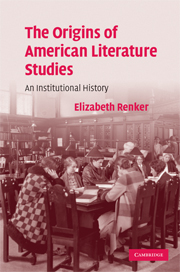Book contents
- Frontmatter
- Contents
- Acknowledgments
- Introduction
- Chapter 1 The birth of the Ph.D.: The Johns Hopkins research model
- Chapter 2 Seminary wars: female teachers and the seminary model at Mount Holyoke
- Chapter 3 Higher education for African Americans: competing models at Wilberforce University
- Chapter 4 Literary value and the land-grant model: The Ohio State University
- Conclusion: the end of the curriculum
- Notes
- Bibliography
- Archives consulted
- Index
Chapter 1 - The birth of the Ph.D.: The Johns Hopkins research model
Published online by Cambridge University Press: 22 September 2009
- Frontmatter
- Contents
- Acknowledgments
- Introduction
- Chapter 1 The birth of the Ph.D.: The Johns Hopkins research model
- Chapter 2 Seminary wars: female teachers and the seminary model at Mount Holyoke
- Chapter 3 Higher education for African Americans: competing models at Wilberforce University
- Chapter 4 Literary value and the land-grant model: The Ohio State University
- Conclusion: the end of the curriculum
- Notes
- Bibliography
- Archives consulted
- Index
Summary
In 1876, The Johns Hopkins University invented the Ph.D. degree that we know today. Both Yale and Harvard had previously awarded doctorates, but they had done so in scant numbers, without programmatic initiative or direction. By 1873, Yale had awarded 90 percent of American Ph.D.s, with an anemic total of twenty-three. The M.A. degree had been more common, but it, too, was an aimless degree awarded without systematic training or clear social purpose. A quip current at Harvard through 1869 reported that you could get the M.A. there for “keeping out of jail five years and paying five dollars.” Simply put, graduate school in the United States had no social meaning. Hopkins transformed the pursuit of an advanced degree from an arcane and marginal academic exercise into a necessary and competitive credential for a new profession: the scholar-expert. The Ph.D. scholar-expert became the Hopkins brand. Inspired by the nineteenth-century German conception of pure research, the Hopkins doctorate certified the Ph.D.'s rigorous training, his ability to pursue original investigation, and his capacity to reproduce his professional skills in subsequent generations of advanced students. Within fifteen years of Hopkins' inception, its Ph.D. model had thoroughly saturated and altered the landscape of American higher education, indeed becoming so hegemonic that its revolutionary freshness in the 1870s is now hard to imagine.
Every institution of higher education in the nation had to contend with the Hopkins Ph.D. as a new social force.
- Type
- Chapter
- Information
- The Origins of American Literature StudiesAn Institutional History, pp. 13 - 39Publisher: Cambridge University PressPrint publication year: 2007



